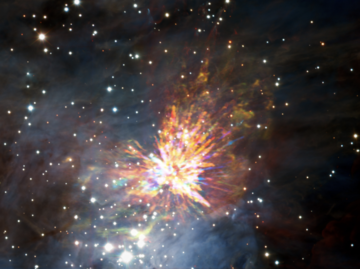2023/10/17
The Istituto Nazionale di Astrofisica (INAF) invites scientists to participate in the call for proposals of observing time at the three national radio telescopes: the 32-m Medicina antenna, the 32-m Noto antenna, the 64-m Sardinia Radio Telescope. Two observing semesters are scheduled every year: 1st January to 30th June, 1st July to 31st December. Deadlines fall in October and April, respectively. The telescopes can be used as single dishes for spectroscopic and continuum observations as well as for VLBI, outside the standard networks coordination (EVN, IVS, etc.) which have their own time allocations. VLBI proposers must take care of organising the availability of international telescopes if needed by their observations. They are also required to contact the antenna staff prior to submission, in order to assess the availability of software/hardware services and operators for their specific needs. Please note that, if granted antenna time, proposers will be in charge of producing the schedule files for their observations. Instructions on the submission procedure, current latex forms and characteristics of the instruments currently available can be found at http://www.radiotelescopes.inaf.it/proposal_main.html ** IMPORTANT ** PLEASE USE ONLY THE LATEST LATEX FORM ** A dedicated help desk for the submission only may be reached via e-mail at radioproposal@inaf.it. The proposals will be peer-reviewed and should be submitted before 12:00 UTC on October 17, 2023. Below we report the time INAF plans to award for the next semester 2024A: Medicina: 2500 hours (1); Noto: 2000 hours (2); SRT: 1500 hours (3). Please note: Noto single-dish observations can now be carried out remotely, as in Medicina. 1) **** MEDICINA ACTIVE SURFACE INSTALLATION **** At some point during semester 2024A, the Medicina dish might be stopped in order to start the installation of the active surface on its primary mirror. The exact timing is not known at the moment. 2) **** NOTO RECEIVERS ONLY PARTIALLY AVAILABLE **** Due to refurbishments and new installations, some receivers in Noto are only partially available or are offered in shared-risk mode. Details are provided in the above-mentioned website. 3) **** SRT IN SHARED-RISK MODE **** SRT is in a high frequency upgrade phase. In the 2024A semester it is offered in "shared-risk" mode and with a limited number of receivers. The observing time offered might be subject to modification, due to maintenance needs and to the variability of the commitments resulting from international agreements. SRT participates in the Transnational Access program of the Opticon Radionet Pilot program. The program can give financial support to a member of eligible projects, to visit SRT for the observations. The Opticon RadioNet Pilot program is funded by the EC Horizon 2020 Research and Innovation Programme under grant agreement No. 101004719 (https://www.orp-h2020.eu/) According to the MOU between INAF and KASI up to 30 hours of observing time in VLBI mode are allocated to approved Eating VLBI projects. These projects have to be submitted both to the Italian and Korean TACs with the standard form selecting "EatingVLBI mode" in the project type. Approved projects will be observed up to 30hrs/semester. Projects exceeding 30 hours will be scheduled together with all other projects according to their relative grades. PIs of these proposals must be associated either with INAF or KASI. Please, feel free to distribute the present call to anyone interested. Best regards, Federica Govoni and Gianfranco Brunetti

 Es el grupo de radioastrónomos del IRyA y sus estudiantes. Nos reunimos cada 15 días con el objetivo de compartir experiencias, resultados recientes, resúmenes de congresos, etc. La imagen muestra uno de los resultados de los investigadores del grupo, basada en datos del Atacama Large Millimeter/submillimeter Array del flujo explosivo de Orion BN/KL (Bally, Zapata et al. 2017).
Es el grupo de radioastrónomos del IRyA y sus estudiantes. Nos reunimos cada 15 días con el objetivo de compartir experiencias, resultados recientes, resúmenes de congresos, etc. La imagen muestra uno de los resultados de los investigadores del grupo, basada en datos del Atacama Large Millimeter/submillimeter Array del flujo explosivo de Orion BN/KL (Bally, Zapata et al. 2017).